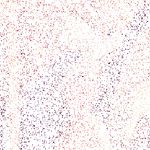Image completion via nonnegative matrix factorization using HALS and B-splines - ESANN 2020
←
→
Page content transcription
If your browser does not render page correctly, please read the page content below
ESANN 2020 proceedings, European Symposium on Artificial Neural Networks, Computational Intelligence
and Machine Learning. Online event, 2-4 October 2020, i6doc.com publ., ISBN 978-2-87587-074-2.
Available from http://www.i6doc.com/en/.
Image completion via nonnegative matrix
factorization using HALS and B-splines
Cécile Hautecoeur and François Glineur∗
Université catholique de Louvain - CORE and ICTEAM Institute
B-1348 Louvain-la-Neuve - Belgium
Abstract. When performing image completion, it is common to assume
that images are smooth and low-rank, when viewed as matrices of pixel
intensities. In this work, we use nonnegative matrix factorization to suc-
cessively refine the image by representing alternatively rows and columns
as smooth signals using splines. Previous work solved this model using
an alternating direction method of multipliers. Instead, we propose to use
a version of the hierarchical alternating least squares algorithm adapted
to handle splines, and show in numerical experiments that it outperforms
the existing method. Performance can be further improved by increasing
progressively the size of used splines. We also introduce a non iterative
algorithm using the same NMF approach, where factorization is computed
in a fast and accurate way but for which convergence is harder to achieve.
1 Introduction
Nonnegative matrix factorization (NMF) is a powerful tool for data analysis that
relies on expressing a nonnegative matrix as the product of two nonnegative low-
rank matrices. This factorization is for instance able to filter noise by reducing
the rank (or dimensionality) of the input matrix [1, 2]. It is quite popular for
many applications, including image completion, where images are represented as
matrices of nonnegative pixel intensities. The low rank assumption, combined
to smoothness conditions, is used in many state-of-the art methods for image
completion. The smoothness is enforced via regularization, either on the pro-
duced image [3], or on its factors [4]. Recently, Sadowski and Zdunek proposed
a different technique where the smoothness constraint is imposed on one factor
of the NMF problem by constraining it to be a linear combination of smooth
elements, namely B-Splines [5]. This approach leads to promising results, but
at the cost of a relatively high computational time. Our goal is to use a similar
idea for image completion while keeping a low computational effort.
2 Image completion with smooth NMF
NMF with spline factors, denoted smooth-NMF, consists in the following prob-
lem: given a matrix Y ∈ Rm×n , a factorization rank r and a (discretized)
B-Spline basis with d splines S ∈ Rm×d , find matrices A ∈ Rm×r and X ∈ Rr×n
∗ This work was supported by the Fonds de la Recherche Scientifique - FNRS and the Fonds
Wetenschappelijk Onderzoek - Vlaanderen under EOS Project no 30468160.
73ESANN 2020 proceedings, European Symposium on Artificial Neural Networks, Computational Intelligence
and Machine Learning. Online event, 2-4 October 2020, i6doc.com publ., ISBN 978-2-87587-074-2.
Available from http://www.i6doc.com/en/.
minimizing
||Y − AX||2F such that A = SB ≥ 0, X ≥ 0. (1)
To use smooth-NMF for image completion, Sadowski and Zdunek proposed in
[5] Algorithm 1, inspired from [4]. This algorithm successively solves a smooth-
NMF problem based on a guess Y of the image to be recovered. This guess is
updated using the low-rank matrix AX produced by NMF, where known pixels
are replaced by their true value. Iterations are stopped once Y is close enough to
AX. To ensure smoothness on both the rows and the columns, smooth-NMF is
performed on the image and on its transpose1 . The error at line 8 is computed
with respect to the initial guess of the image (Y ) because the image can be
smoother in its rows or its column, and the error can thus increase between line
5 and 7. Nevertheless, we want this error to decrease after each full iteration.
Algorithm 1 B-Splines-based Algorithm for Image Completion (BSA-IC)
Input: M ∈ Rm×n is the incomplete matrix with support Ω. Y is a first guess
for M , by default 0m×n , A ∈ Rm×r and X ∈ Rr×n are initialized randomly if
not provided. A is initialized to contain nonnegative splines.
function BSA-IC(M , Ω, Y , A ≥ 0, X ≥ 0, δ = 10−1 )
2: YΩ = MΩ , Z = Y − AX, ZΩ̄ = 0 Z contains the initial error
e2 = ||Z||, e1 = e2 + δ + 1
4: while e1 − e2 > δ do
(A, X) = Smooth-NMF(Y, A, X) Smooth rows
6: Y2 = AX, Y2 Ω = MΩ
(X , A ) = Smooth-NMF(Y2 , X , A ) Smooth columns
8: Z = Y − AX, ZΩ̄ = 0 Error with respect to Y
e1 = e2 , e2 = ||Z||
10: Y = AX, YΩ = MΩ
end while
12: return Y
end function
To solve the smooth-NMF problem, the authors used the algorithm from
[6], which solves the problem alternatively in matrices A and X. Matrix X
is updated using the popular Hierarchical Alternating Least Squares (HALS)
method [7], while matrix A is updated with and Alternating Direction Method
of Multipliers (ADMM) [8]. As the HALS update of X is quite common, we
only explain the ADMM update of A: it solves
min 21 ||Y − SBX||2F + Φ(A) such that SB = A (2)
A,B
where Φ(A) is the indicator function of the nonnegative set (Φ(a) = 0 if a ≥ 0,
+∞ otherwise). Applying ADMM on this problem gives the following iterative
1 Note that lines 5 to 7 where inferred from descriptions in [5], as the authors did not provide
pseudocode of these elements. Moreover, the condition of the while loop has been slightly
modified by removing the absolute value to stop the algorithm when the error increases.
74ESANN 2020 proceedings, European Symposium on Artificial Neural Networks, Computational Intelligence
and Machine Learning. Online event, 2-4 October 2020, i6doc.com publ., ISBN 978-2-87587-074-2.
Available from http://www.i6doc.com/en/.
scheme, using [ξ]+ = max{0, ξ}, τ > 0 and the pseudo-inverse S † :
−1
Bk+1 = S † Y X + Λk + τ Ak XX + τ Ir
Ak+1 = SB k+1 − τ −1 Λk + , Λk+1 = Λk + τ (Ak+1 − SB k+1 ).
Algorithm 1 is able to complete images properly, but at the cost of a high
CPU time compared to existing approaches. We propose to tackle the smooth-
NMF subproblem using S-HALS, a method introduced in [9] based on HALS.
This method is potentially faster than the ADMM approach provided fast heuris-
tics are used to project splines onto their nonnegative set. Indeed, it has been
shown that using heuristics for the projection step could benefit the algorithm
in terms of CPU time without impacting significantly its accuracy [10].
Our S-HALS method alternates between updates of matrix B (the coefficients
of A = SB) and matrix X, as described in Algorithm 2. Projection in line 5 of
updateB can be done exactly (see [9]), but instead we choose to compute it in an
approximate but much faster way: we project each B-Spline coefficients on the
nonnegative set, which ensures that the resulting spline is nonnegative (although
not all nonnegative splines can be obtained in this way).
Algorithm 2 S-HALS
Π = S S, Z = S Y, Π1 = Π−1 Z
1: function updateB(Π1 , B, X) function updateX(Z, Π, B, X)
2: P = Π1 X , Q = XX P = B Z, Q = B ΠB
3: for b:k in B do
for xk: in X
do
4: t = p:k − j=k b:j qjk t = pk: − j=k qkj xj:
5: b:k ← Projection(t/qkk ) xk: ← max(0, t/qkk )
6: end for end for
7: return B return X
8: end function end function
3 Direct image completion (DIC) via HALS using splines
The image completion method described above relies on an input guess of the
complete image, which is successively refined using smooth-NMF. Below we con-
sider a different paradigm based on a single low-rank completion of the input.
Given a matrix M ∈ Rm×n whose entries are known on support Ω, the
problem of low-rank completion can be written as
min C(A, X) = (Mi,j − [AX]i,j )2 . (3)
A∈Rm×r ,X∈Rr×n
(i,j)∈Ω
Since Algorithm 1 was alternating between imposing smoothness on the rows
and on the columns of the image, we propose in our new model to impose both
at the same time, by constraining both A and X to contain splines with nonneg-
ative coefficients. We then solve (3) using a HALS approach similar to above,
75ESANN 2020 proceedings, European Symposium on Artificial Neural Networks, Computational Intelligence
and Machine Learning. Online event, 2-4 October 2020, i6doc.com publ., ISBN 978-2-87587-074-2.
Available from http://www.i6doc.com/en/.
applied to both factors and adapted to deal with an incomplete input matrix.
Equating the gradient of the cost C with respect to Ap,q to zero gives
∂C
=− 2(Mp,j − Ap,k Xk,j )Xq,j
∂Ap,q
(p,j)∈Ω k
∂C (p,j)∈Ω Mp,j − k=q Ap,k Xk,j Xq,j
= 0 ⇔ A∗p,q = 2
∂Ap,q (p,j)∈Ω Xq,j
Values in column A:,q are independent from each other, so we can compute
the optimal value A∗:,q of the whole column at once. However, we must also
ensure that A:,q contains splines with nonnegative coefficients. Hence, in order to
obtain the optimal update of column A:,q , we must solve the following quadratic
problem to find the optimal coefficients:
argming∈Rd g S DSg − 2A∗,
:,q DSg s.t. g≥0
where S ∈ R m×d
contains the d considered
B-Splines, and D is a diagonal
2
matrix with diagonal components dp = (p,j)∈Ω X q,j . The solution of this
problem is approximated by projecting the best unconstrained coefficients (g ∗ =
(S DS)−1 S DA∗:,q ) on the nonnegative set. The update of A:,q is then S[g]+ .
As the problem is symmetric in its two factors, we can use the fact that
Y = X A to derive the updates of the rows of X from the updates of the
columns of A. The algorithm iteratively updates A and X until the cost C
−Cactual
< 10−3 ).
C
stagnates ( previous
Cinitial
4 Experiments
We use cubic B-Splines in our tests on a 512 × 512 boat image (see Fig. 2) with
90% missing pixels. Choosing the number of B-splines to be used is an important
component in all the proposed algorithms: one can either choose a fixed number
(50 or 100), or perform a run with some number of splines and use its final
image as input for a subsequent run with more splines (we tried 50 → 100
and 25 → 50 → 100). Two more types of runs are reported: in an ’inner’
run, as suggested in previous work [5], the number of B-splines is incremented
progressively during the update of matrix A [6]. However we did not find that
tweak, where the increase happens at each iteration of Algorithm 1, to be very
effective. Instead we designed an ’outer’ run, similar in spirit to the successive
50 → 100 and 25 → 50 → 100 runs, where a different number of B-Splines is
used at each iteration of Algorithm 1: we use min(3 ∗ i + 10, 100) splines for the
ith iteration (increasing the number of splines by 3 at each iteration prevents
too quick stagnation).
Figure 1 (left) establishes that our methods (Alg. 1 with S-HALS, and DIC)
are both more efficient than Alg. 1 with ADMM (up to four times as fast).
The signal to interference ratio (SIR) with respect to the true image (right)
is best for S-HALS whatever the number of splines used. We also see that
76ESANN 2020 proceedings, European Symposium on Artificial Neural Networks, Computational Intelligence
and Machine Learning. Online event, 2-4 October 2020, i6doc.com publ., ISBN 978-2-87587-074-2.
Available from http://www.i6doc.com/en/.
DIC does not really benefit from the subsequent runs in the 50 → 100 and
25 → 50 → 100 cases, most probably because it does not make significant use
of each intermediate input image. For this reason neither the ’inner’ nor the
’outer’ runs where tested on this algorithm. However, SIRs for both ADMM
and S-HALS benefit from increasing progressively the number of splines and
they benefit much more from ’outer increases’ than from the ’inner’ run. An
explanation for this improvement could be that the image is first reconstructed
from its low-rank elements, and then improved [4].
50 100 50-100 outer inner 50 100 50-100 outer inner
25-50-100 25-50-100
Fig. 1: Performance of the methods with varying number of B-Splines.
We also analyzed the methods with different choices of factorization rank r.
In general, they obtain better results with higher rank, but at the cost of more
computational effort. Moreover, the benefits for r > 50 are very small. Worse,
the DIC method is not always able to converge when r is high (r > 100, see also
discussion below). We also observed the influence of the percentage of missing
pixels, and saw that the three methods are still able to recover a quite accurate
image (with a SIR around 15.5 dB) even when 95% of pixels are missing.
Finally, Figure 2 displays several examples of recovered images with 90 %
missing pixels, with rank fixed to 50 for the 512 × 512 grayscale image and 25
for the 256 × 256 color images (for which algorithms were applied on each color
channel independently). ADMM as well as S-HALS use an ’outer’ run with a
maximal number of splines equal to 100. We observe on all three images that
S-HALS is significantly faster and slightly more accurate than ADMM, while
DIC is the fastest method but also the least accurate.
5 Conclusion and discussion
The presented methods work with fixed rank. A way to find the best rank is
to increase it progressively until the image is close enough to the known pixels
[4]. This approach is quite easy to implement for Algorithm 1, and at each
step the algorithm will take advantage from the image computed at the previous
iteration. On other hand the DIC algorithm must be modified to better exploit
information from a previous completion, which we leave for further research.
This modification would also probably allow the algorithm to take advantage
from a progressive increase in the number of splines.
Extending our approaches to tensors is another interesting topic for future
work, which could be applied to colored images for which pixel intensities in
each color channel are not independent, unlike what we did with our algorithms.
77ESANN 2020 proceedings, European Symposium on Artificial Neural Networks, Computational Intelligence
and Machine Learning. Online event, 2-4 October 2020, i6doc.com publ., ISBN 978-2-87587-074-2.
Available from http://www.i6doc.com/en/.
Original image Input image ADMM S-HALS DIC
(1324 s.-18.19) (174 s.-18.29) (102 s.-17.36)
(766 s.-18.23) (174 s.-18.41) (39 s.-15.48)
(931 s.-14.82) (188 s.-14.9) (39 s.-13.09)
Fig. 2: Example of recovered images for 90% of missing pixels. (CPU time - SIR).
References
[1] Daniel D Lee and H Sebastian Seung. Learning the parts of objects by non-negative
matrix factorization. Nature, 401(6755):788, 1999.
[2] Andrzej Cichocki, Rafal Zdunek, Anh Huy Phan, and Shun-ichi Amari. Nonnegative
matrix and tensor factorizations: applications to exploratory multi-way data analysis
and blind source separation. John Wiley & Sons, 2009.
[3] Yipeng Liu, Zhen Long, and Ce Zhu. Image completion using low tensor tree rank and
total variation minimization. IEEE Transactions on Multimedia, 21(2):338–350, 2018.
[4] Tatsuya Yokota, Qibin Zhao, and Andrzej Cichocki. Smooth parafac decomposition for
tensor completion. IEEE Transactions on Signal Processing, 64(20):5423–5436, 2016.
[5] Tomasz Sadowski and Rafal Zdunek. Image completion with smooth nonnegative matrix
factorization. In International Conference on Artificial Intelligence and Soft Computing,
pages 62–72. Springer, 2018.
[6] Rafal Zdunek. Alternating direction method for approximating smooth feature vectors
in nonnegative matrix factorization. In 2014 IEEE International Workshop on Machine
Learning for Signal Processing (MLSP), pages 1–6. IEEE, 2014.
[7] Andrzej Cichocki, Rafal Zdunek, and Shun-ichi Amari. Hierarchical ALS algorithms
for nonnegative matrix and 3D tensor factorization. In International Conference on
Independent Component Analysis and Signal Separation, pages 169–176. Springer, 2007.
[8] Tom Goldstein, Brendan O’Donoghue, Simon Setzer, and Richard Baraniuk. Fast alter-
nating direction optimization methods. SIAM Journal on Imaging Sciences, 7(3):1588–
1623, 2014.
[9] Cécile Hautecoeur and François Glineur. Nonnegative matrix factorization over continu-
ous signals using parametrizable functions. Neurocomputing, 2019.
[10] Cécile Hautecoeur and François Glineur. Accelerating nonnegative matrix factorization
over polynomial signals with faster projections. In 2019 IEEE 29th International Work-
shop on Machine Learning for Signal Processing (MLSP), pages 1–6. IEEE, 2019.
78You can also read



























































